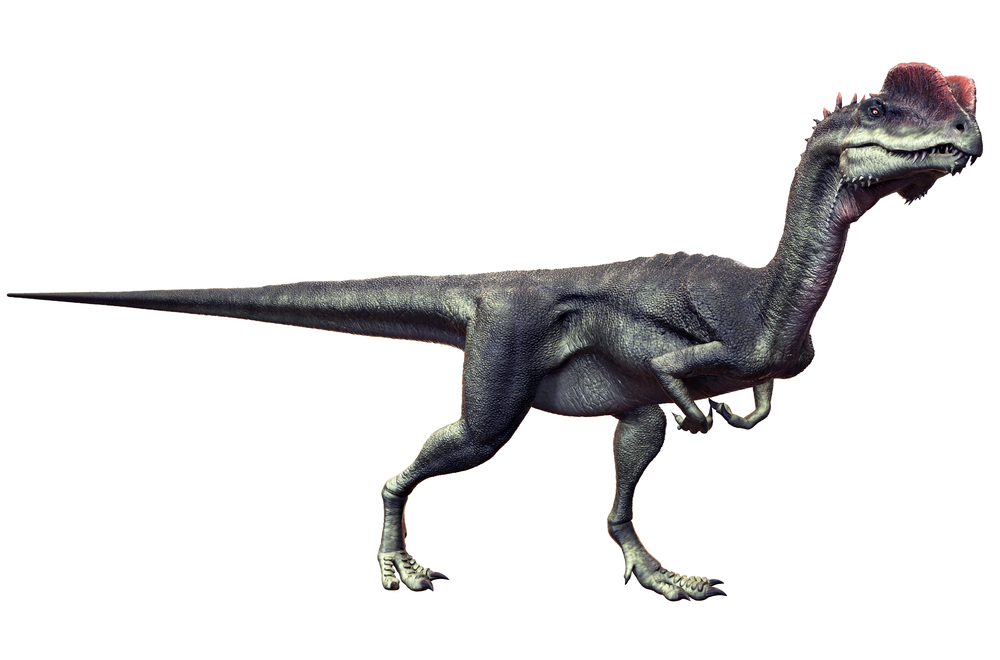Table of Contents (click to expand)
Dilophosaurus is a genus of theropod dinosaurs that roamed North America during the early Jurassic Period. Popularized (inaccurately) by the Jurassic Park film franchise, these two-crested creatures continue to fascinate paleontologists to this day!
You probably remember the scene from Jurassic Park—when Dennis Nedry (the nerdy computer programmer) nearly makes his escape from the island after stealing all the dinosaur DNA, only to crash his Jeep, then be spat on and devoured by a swarm of dinosaurs in the middle of the movie’s climactic storm? Those small creatures had poisonous venom and a huge frill around their heads in the movies, and were called Dilophosaurus in the books by Michael Crichton, but was that an accurate depiction? Were these dinosaurs vengeful pack hunters with such a Hollywood-friendly edge? Not exactly.
While you probably know not to trust Hollywood magic, it’s time we clear the air about the Dilophosaurus and set the record straight!
What Is A Dilophosaurus?
Dilophosaurus is a genus of terrestrial theropod dinosaurs that lived approximately 190-193 million years ago, during the beginning of the Jurassic period.
An adult dinosaur of this type likely weighed about 900 pounds and stretched for 9 meters, with much of that being occupied by the tail and neck. In comparable terms, this dinosaur would be about the size of a brown bear, but with a long and powerful tail. The dinosaur had moderately sized arms and long fingers, as well as one prominent finger that ended in a claw.

The dinosaur stood on two feet, was a fast, slender and agile predator, and probably sat very much like modern-day birds—though they likely did not have feathers! Its unique jaw construction only featured a weak connection between the upper and lower jaw, meaning that it wouldn’t have had a very powerful bite. As a result, it is believed that these dinosaurs either fed on small creatures (perhaps even fish!) or hunted in packs in order to bring down larger prey. Some have even proposed that these creatures scavenged from dead carcasses, due to their unusually weak bite.

This genus was only discovered in the mid-20th century in Arizona, in a scattering of skeletons called the Kayenta Formation, near Tuba City. Following a paleontological survey of the area, a local Navajo man, Jesse Williams, showed the members of the expedition bones he had found years earlier. These three skeletons remain the best-preserved examples of this genus, in addition to the nearly complete skeleton found in 1964.
In 1954, the dilophosaurus was categorized in the catch-all Megalosaur genus, which was home to hundreds of basic theropods with somewhat similar features. However, 16 years later, Dilophosaurus was granted its own genus, thanks to the defining double crests on its head, which were not present in any other Megalosaur genera. These crests were only found on the specimen of this dinosaur discovered in 1964, not the original 1940 discovery. It is believed that not all Dilophosaurus individuals had the double-crest on its head, as it may have only been present on males, and used as a secondary sexual characteristic for mating appeal.
Also Read: What Is A Carnotaurus?
Spitting Dinosaur: A Hollywood Exaggeration
While Jurassic Park may have brought the idea of a dilophosaurus into the public consciousness, the directors and producers weren’t overly worried about accuracy. For one thing, the dilophosaurus was the only dinosaur represented in the movie that was actually from the Jurassic Era, with the other six major species being found in the Cretaceous. More specifically though, the depiction of dilophosaurus as a small, dog-sized dinosaur is objectively false.
The most dramatic scene involving this dinosaur is when a large pack of these dinosaurs attacks the hapless villain of the story as he tries to make his escape. While some experts believe that these dinosaurs could have used their crests for communication, and pack hunting, there is no clear evidence that they spent time in such concentrated numbers. Furthermore, one of the dinosaurs dramatically spits venom into the villain’s face, but there is also no evidence for this as a defensive maneuver or an attack strategy in the full-sized Dilophosaurus discovered in Arizona.

The frills around the dinosaurs neck that spread open and scares the dickens out of Dennis Nedry (played by actor Wayne Knight, of Seinfeld fame), are also a piece of fiction. They vaguely resemble the same crests that would have been found on this dinosaur’s head, but they were highly exaggerated in size. All of that being said, Hollywood is known to take liberties with far worse details!
Also Read: Why Earth No Longer Has Animals As Huge As Dinosaurs?
A Final Word
Though your first introduction to this species of dinosaurs was anything but accurate, now you know the truth of these mighty creatures, some of the strongest and fastest theropods of the early Jurassic Period. Not only that, but given their high metabolic demands, some paleontologists argue that these could have been warm-blooded animals, which connects to the fascinating evolution of endothermy, which developed more than once in the history of life on this planet!
Also Read: Are Birds Really Reptiles?
How well do you understand the article above!

References (click to expand)
- M Szewczak —. Dilophosaurus - Encyklopedia Dinozaury.com. encyklopedia.dinozaury.com
- Kundrát, M. (2004, July 15). When did theropods become feathered?-evidence for pre-archaeopteryx feathery appendages. Journal of Experimental Zoology Part B: Molecular and Developmental Evolution. Wiley.
- R Gay. NEW SPECIMENS OF DILOPHOSAURUS WETHERILLI .... CiteSeerX
- Rowe, T. (1989, June 30). A new species of the theropod dinosaurSyntarsusfrom the Early Jurassic Kayenta Formation of Arizona. Journal of Vertebrate Paleontology. Informa UK Limited.
- Sakamoto, M. (2010, June 9). Jaw biomechanics and the evolution of biting performance in theropod dinosaurs. Proceedings of the Royal Society B: Biological Sciences. The Royal Society.
